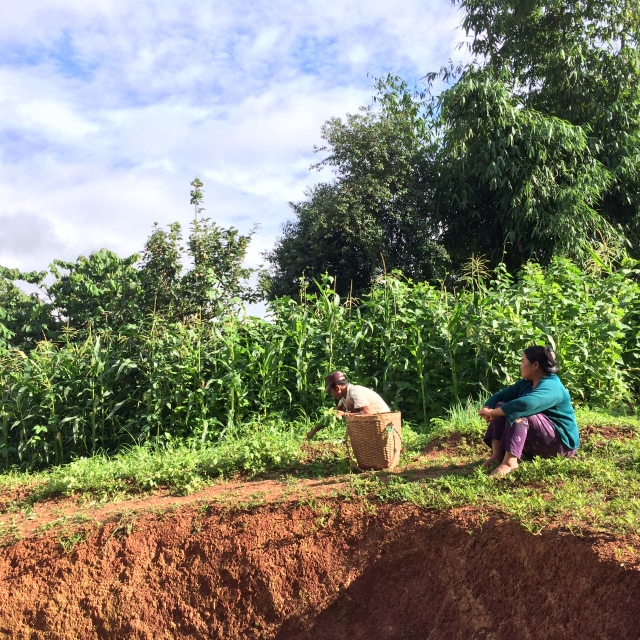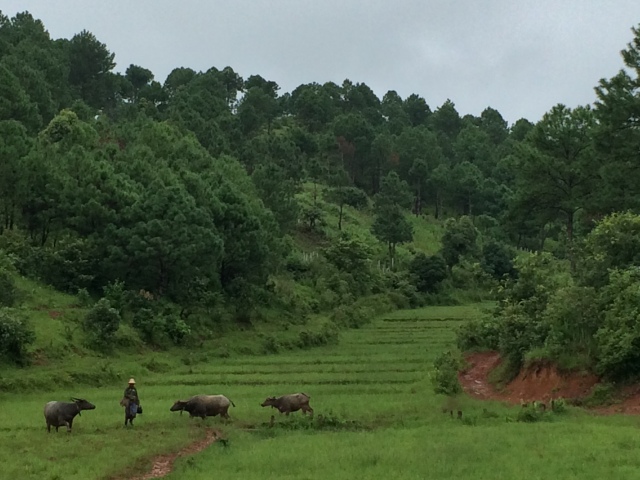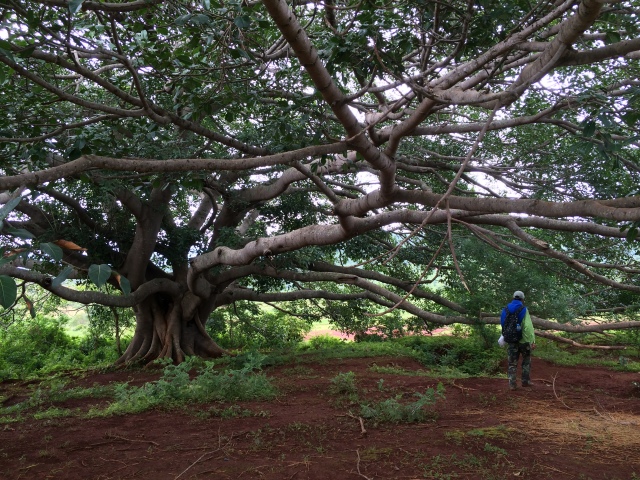It was a difficult decision but Chris and I decided to journey separately for the next 3 days and 2 nights due to his everlasting cough. Chris probably needed about three or even four more days to completely recover, and we were stuck in a village with no internet and nothing much to do. With a strict deadline of our return home approaching, I felt pressured to do everything I could do with the time we had remaining. It was either I go, or both of us don’t go at all.
We came to the decision that I would do this trek alone—which a majority of Myanmar visitors say is “the highlight” of their trip—while Chris would rest in Kalaw and later meet me at Inle Lake.
I woke up the morning of my trek to the sound of rain. I read the worst time to trek in Myanmar is during the rainy season due to downpours and slippery mud, but I figured it would be a good story, so why not? By 8:30am I was at Ever Smile trekking company, and by 9 the rain stopped and I was on my way with my guide, Mg Mg (pronounced Maung Maung). I read a good review about Mg Mg on TripAdvisor, so I had previously requested him. Thanks to the low season, I was the only trekker (which meant I had to pay more, but it was worth it).
To my relief, that entire day delivered nothing more than a light drizzle, but it bestowed plenty of mud that weighed down our legs as we dragged ourselves up and down the Myanmar mountain countryside. Albeit wet and slippery, I found myself favoring the cool, rainy season as opposed to of the cool, dry season of November through February (perfect weather, crowds of people) or the sunny, dry season of March through May (scorching hot). With the slight drizzle and thick, gray clouds overhead, I was reminded of San Francisco and Marin County, which has the perfect weather for hiking. It actually hardly rained throughout the trek, despite what travel books had warned.
Rest stop #1 at a Nepalese family’s home:

Throughout the day we trekked up and over hills, passed through farms and schools and villages, and took tea breaks in villages and shops. Mg Mg entertained me by telling me jokes, stories, and Myanmar village folk tales. More importantly, he filled me in with information on the Myanmar lifestyle, history, culture, and a deeper look into his family and upbringing. We were the same age (28 years) and it fascinated me how much our lives contrasted due to the opportunities our countries had provided us. Despite having an university degree, his work included hard labor at a cement factory where he got infected with malaria, setting up electric cables for new buildings at $2.50/day, selling juice out of his home, and finally becoming a trekking guide for about $10/day. (Remember that during the low season, treks are seldom at maybe two or three 2-day long treks per month.) As someone born and raised in Silicon Valley, I know that my options for education and careers are some of the best in the world. Listening to his stories again reminded me how fortunate I am to be born and raised in the United States.
By the end of the day, I learned how to count one through a thousand in Burmese, and I learned how to say, “How much?”
Rest stop #2 at an antiquated railway station:
This scale was probably older than me. It was used to weigh luggage and goods. Although their country is now making strides toward the metric system, they have their own unit of measurement: viss. 1 viss is about 1.6 kilograms.

By late afternoon we arrived at the house in Ywar Pu village, where we would be spending the night. There were a few guesthouses in the village that provided a place to sleep for trekkers like myself. Thanks to the low season, I was the only guest there that night. Like all the houses in the village, there was no running water or electricity. They depended on solar energy to light their free-hanging light bulbs and small television set, and they also collected rain water in cement cisterns to use for drinking, cooking, washing dishes, and bathing.
This was the house. The bottom floor was the kitchen and storage area, and the upper floor was the living/sleeping area.






The area for washing dishes, an open cistern, and the trail leading up to the outhouse:
Mg Mg washing his feet in the bathing area using the water from the cistern:
This fairly large house belonged to a husband and wife in their late 30s, their two teenage daughters, and their young son. The husband worked as a traveling cook for other trekkers, the mother farmed, and their oldest daughter picked crops at another farm to earn extra money. Like any other teenage girl, they were giggly and enjoyed to sing, and would apply the bit of makeup they owned to their round faces to feel pretty. They were incredibly sweet and always smiled at me, shyly dodging my camera when I pointed it in their direction.
My first night in their home was the most authentic experience I’ve had in all of Southeast Asia. The fierce rain pounding on the metal roof forced my guide and I to shout at each other over dinner in order to be heard.
After a fantastic dinner, the mother took our plates and fed our leftovers to her family. Then the two sisters put on their straw Burmese hats, a poncho, and went outside to wash the dishes in the rain. Before I proceeded to bed, I put on my poncho and stepped out into the rain where I watched the girls happily sing and finish up the dishes. Being careful not to slip in the mud, I slowly staggered up to the outhouse that naturally had a non-flushing squat toilet.
As I brushed my teeth, I looked into the deep cistern and watched a number of worms wriggling around.
Finally I turned off the single light switch for the entire house (which turned off all the lights), crawled into my lone bed in the corner of their living room, and fell asleep to the pounding rain.
Mg Mg helped apply the traditional thanaka to my face before setting out the next morning. First, you take out a slab of thanaka.
Then apply a dab of water to a stone slab:
Rub the thanaka bark in a circular motion until a creamy mixture forms.
Then apply to the face! Beautiful!
A photo of the husband the next morning, picking crops:
And a photo of me and the lady of the house before setting out:
Mg Mg told me Day 2 promised the most difficult day of trekking due to the exhaustion gained from Day 1, the distance needed to travel to the next guesthouse, the open fields that offered no protection from the sun, and the mud caused by last night’s rain. Fortunately the cloud cover kept us cool most of the day. The sun did come out for one brutal hour, but immediately after it disappeared, rain clouds appeared and dumped on us for only five minutes.








Trekking up a narrow dirt path up a hill in a poncho with rain pouring down proved to be irritating, but not as irritating as the road conditions the rain bequeathed. Our last hour was brutal; I felt slightly dazed from fatigue as we trekked our final miles up an incredibly muddy hill, each step feeling heavier and heavier as the mud clung on.

Alas, we made it to the guesthouse in Pattu Baukat at a quarter until 5pm, and I enjoyed my traditional Myanmar bath hovering in the corner of a dark, wooden shack with a pan and cold water. I even managed to get four mosquito bites as I poured the frigid water over my mud-covered body, including one on my butt!
That night I slept in a super stuffy box of a room filled with stagnant air.
And I was woken up to the smell of smoke emitting from the kitchen outside my window.
For Day 3, Mg Mg told me we would trek in the morning, finish the trek with lunch, and then cross Inle Lake by boat. He estimated it would take four hours, but my competitive spirit kicked in and we quickly passed up each group ahead of us, resulting in a three and a half hour finish time! WHOO! After trekking approximately 42 miles over the past two and a half days in countryside mountain rain, sun, and mud, my legs and lower back were done. (The short yoga session I quickly gave Mg Mg on the evening of Day 1 didn’t really help either.)
The sliver of Inle Lake as seen from a distance:
After lunch, we climbed into a little boat and enjoyed the one-hour ride across Inle Lake into the modest tourist town of Nyaung Shwe.
A brilliant blue sky filled with fluffy white clouds served as a lovely backdrop as we zoomed past the straw stilt houses.


As we passed other boats, excited locals would point and wave, sometimes even shouting, “HELLO!” I think they were more interested in the European tourists (basically non-Asian looking people) sitting behind me, but I cheerfully waved back anyway.
The boat harbor was literally just a few meters away from our hotel in Inle Lake. A quick stroll across the bridge allowed me to reunite with Chris within minutes. The past 3 days and 2 nights coated me in sweat, dust, mud, and a shit load of bug bites, but my heart was filled with a sweet love for foreign people and culture, particularly Myanmar and its gentle people. Even the smallest glimpse into rural villages will make one understand the beauty and pleasures of a simple, community-driven lifestyle that we seldom see in the modern world of the West.



















